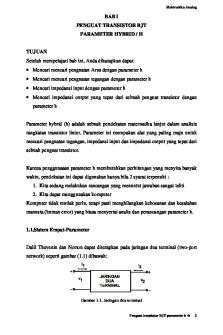ELE202-Project - analog signal PDF

| Title | ELE202-Project - analog signal |
|---|---|
| Course | Devre analizi |
| Institution | TOBB Ekonomi ve Teknoloji Üniversitesi |
| Pages | 2 |
| File Size | 99.5 KB |
| File Type | |
| Total Downloads | 87 |
| Total Views | 148 |
Summary
analog signal...
Description
Electrical Circuits (ELE 202) Project Fall 2018 Touch-tone Telephone (DTMF Decoder)
This project detects the dial tone from a telephone line and decodes the keypad pressed on the remote telephone. The dial tone we hear when we pick up the phone set is call Dual Tone Multi-Frequency, DTMF in short. There are twelve DTMF signals, each of which is made up of two tones from the following selection: 697 Hz, 770 Hz, 852 Hz, 941 Hz, 1209 Hz, 1336 Hz, 147Hz. The tones are divided into two groups (low and high), and each DTMF signal uses one from each group. This prevents any harmonics from being misinterpreted as part of the signal. The following table shows the frequencies used for each signal.
It uses electronics and computer to assist in the phone line connection. Basically on the caller side, it is a dial tone generator. When a key is being pressed on the matrix keypad, it generate a unique tone consisting of two audible tone frequency. For example, if the key '1' is being pressed on the phone, the tone you hear actually consists of a 697 Hz & 1209 Hz sine signal. Pressing key '9' will generate the tone form by 852 Hz & 1477 Hz. The frequency use in the dial tone system is of audible range suitable for transmission over the telephone cable. On the telephone exchange side, it has a decoder circuit to decode the tone to digital code. For example, the tone of 941 Hz + 1336 Hz will be decoded as binary '1010' as the output. This digital output will be read in by a computer, which will then act as a operator to connect the caller's telephone line to the designated phone line. The telephone exchange center will generate a high voltage signal to the receiving telephone, so as to ring the telephone bell, to notified the receiving user that there is an incoming call.
1. The touch-tone voice inputs for 0 to 9, # and * buttons are attached to the Project as a zip file. Using these voice inputs, design the DTMF decoder circuit using P-Spice software and explain how the circuit works. 2. Try to include the logic behind the outputs and show that changing the input from 0 to 9, we can observe the corresponding binary and decimal output. 3. In the P-spice environment, you clearly need to show all the circuit schematics. Your circuit needs to show the necessary output signals on the P-spice environment. The project that do not clearly show the output signals will not be accepted as “operational”. 4. The project groups will be composed of 5 people. Please follow the instructions on the Piazza website for group formation. 5. You need to prepare a project report and print a hard copy (each group will only prepare one report) and then make a 5-minute demo in the presence of TA’s in Technology Center (to be announced) that your circuit is operational. In the report, you need to describe the design, the logic behind your design, required outputs, and work load distribution in your group. 6. During the demo, the TAs will ask you questions regarding the general idea and your involvement implementing the project. Separate grades will be given to each person. Please remember that you will strictly have 5 minutes to present your work....
Similar Free PDFs

ELE202-Project - analog signal
- 2 Pages

1.2.2.AK Analog Digital Signal
- 6 Pages

Elektronika Analog
- 17 Pages

Elektronika Analog
- 37 Pages

ELEKTRONIKA ANALOG
- 86 Pages

Signal Phrases
- 1 Pages

Digital Signal Processing
- 168 Pages

Sonar Signal Processing
- 14 Pages

matlab signal generations
- 48 Pages

Digital vs Analog NGSS
- 2 Pages

Analog Circuits lecture notes
- 128 Pages

SISTEM ANALOG DAN DIGITAL
- 13 Pages

Sistem Kontrol Temperatur Analog
- 4 Pages

Analog and Digital Communication
- 242 Pages

Online course Analog Circuits
- 4 Pages
Popular Institutions
- Tinajero National High School - Annex
- Politeknik Caltex Riau
- Yokohama City University
- SGT University
- University of Al-Qadisiyah
- Divine Word College of Vigan
- Techniek College Rotterdam
- Universidade de Santiago
- Universiti Teknologi MARA Cawangan Johor Kampus Pasir Gudang
- Poltekkes Kemenkes Yogyakarta
- Baguio City National High School
- Colegio san marcos
- preparatoria uno
- Centro de Bachillerato Tecnológico Industrial y de Servicios No. 107
- Dalian Maritime University
- Quang Trung Secondary School
- Colegio Tecnológico en Informática
- Corporación Regional de Educación Superior
- Grupo CEDVA
- Dar Al Uloom University
- Centro de Estudios Preuniversitarios de la Universidad Nacional de Ingeniería
- 上智大学
- Aakash International School, Nuna Majara
- San Felipe Neri Catholic School
- Kang Chiao International School - New Taipei City
- Misamis Occidental National High School
- Institución Educativa Escuela Normal Juan Ladrilleros
- Kolehiyo ng Pantukan
- Batanes State College
- Instituto Continental
- Sekolah Menengah Kejuruan Kesehatan Kaltara (Tarakan)
- Colegio de La Inmaculada Concepcion - Cebu
